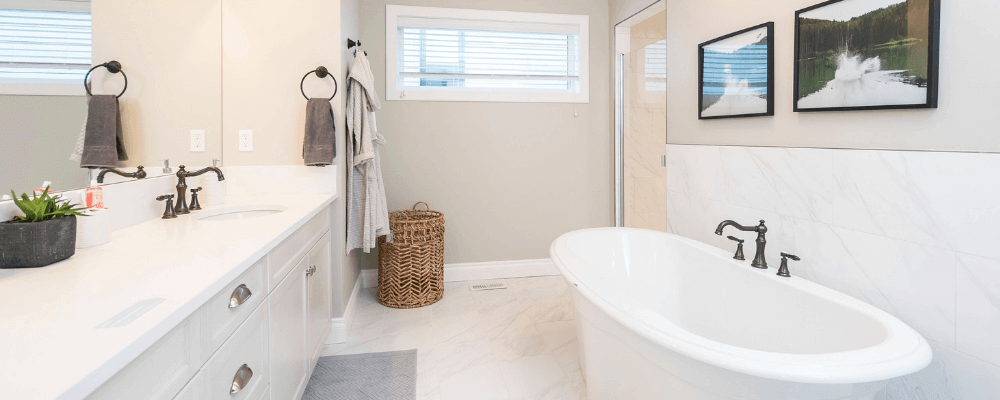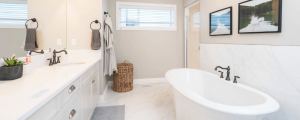Many think plumbing problems happen suddenly, erupting with a severity that hurts your wallet. The truth, though, is that most plumbing problems develop slowly over time and are avoidable if you pay attention to the right things and know when to replace fixtures, appliances, and plumbing parts. Remember, “there’s no such thing as an emergency when you’re plumb smart,” and our goal is to keep you from having emergencies that are costly and difficult. Read the folling plumbing guide to prevent plubming emergencies.
Here you’ll find a comprehensive checklist of rooms and appliances to check periodically to make sure everything is running as it should. The most common rooms are the kitchen and bathroom because they see the most use. But don’t forget to check on other appliances in and outside your home and in places like your basement.
Bathroom
Let’s start in the place that every member of your household uses — the bathroom. Here are the things to check and look for:
-
Faucets
- This includes a sink, tub, and shower faucets. You should check them regularly for leaks and replace bad washers or cartridges to fix dripping faucets. Here are some tips on how to do that. You’ll want to fix a leaky or dripping faucet as soon as possible because while the drip may seem slow, the costs associated with it add up fast. If you notice water damage on the walls or ceiling, it could indicate major hidden damage and you’ll want to call a plumber for that. If it seems like the water pressure if weak or there’s an irregular spray pattern, that could be because of a calcium buildup on the aerator. These can be removed and cleaned or you can remove the buildup by soaking in vinegar.
-
Drains
- Sink, shower, and tub drains are prone to hair clogs and soap buildup. Instead of waiting until you’re standing in two inches of water or have to wait a few minutes for the sink water to drain out, you should disassemble the drain traps and remove the clogs. This will prevent full blockages which cause pressure which can become costly fast.
-
Toilets
- Because a toilet has a lot of working and moving parts, any one of them can wear out and start causing problems. If your toilet rocks at all when you sit on it, then it’s likely that the wax ring needs to be replaced. Water seeping around the base can also be an indication of a worn-out wax ring. Here are some tips on the type of ring to buy and how to replace them. Finally, remove the tank lid and study what happens when you flush the toilet. If it keeps running instead of shutting off at the end of the cycle, it’s wasting a lot of water … and money.
-
Caulk seals
- Okay, technically this isn’t “plumbing,” but if it fails, then you have a plumbing problem and water damage that is expensive to clean up. Moving on … you should periodically check all the caulking along the walls and floors of your tub and/or shower to make sure it’s not broken and is intact. Seal any gaps or cracks you find with fresh caulk. In fact, it’s a good idea every few years to remove the old caulk and use caulk from a new bottle.
Kitchen
Okay, now that you have your bathroom inspection list, let’s move to the next room with heavy plumbing usage — your kitchen. You should plan to inspect all these fixtures at least twice a year and fix the problems you find.
-
Sink drains
- If your sink seems to be draining slowly, call me to get a jar of Bio-Clean to clear out any clogs and then start using Bio-Clean regularly to prevent future problems. Your sink strainer is a common place where leaking can occur. Your P-trap fittings may need to be tightened, and you should replace the strainer basket when you notice it leaking or becoming corroded.
-
Faucet
- A leaking faucet in your kitchen is probably the single most common plumbing issue there is, and quietly costs you lots of money and hundreds of gallons of water each year. Pay attention to this and repair or replace the faucet when it needs it.
-
Shut off valves
- These valves are designed to control the water supply to your faucets, dishwasher, and refrigerator water lines and are also supposed to completely stop the flow of water when they’re closed. As you inspect your appliances, be sure to check these, too. If they aren’t shutting off the water completely, you need to have them replaced. The sooner the better.
-
Garbage disposal
- If your disposal smells, you’ll want to clean it. Most issues with your garbage disposal will show up in the drain connections either where the dishwasher discharge connects to the disposal, or where the disposal discharge runs to the sink drain. You may need to tighten some connections or replace gaskets if they’re leaking. Here are some of my best tips for your garbage disposal health.
-
Dishwasher
- As you inspect appliances in your kitchen, pause and listen to your dishwasher in action. If it’s too slow to fill, you may have a problem with the water supply hose or the shut-off valve connected to the dishwasher. If it’s too slow to drain, or if the water stays in the bottom after the cycle is finished, inspect the water discharge hose for pinching or clogs.
-
Refrigerator
- Don’t forget to replace your filter regularly if your fridge has a water dispenser and/or ice maker. Most of the time this should happen twice a year. You’ll also want to check the water supply hose for signs of wear and replace if it looks rough.
Septic and Sewer
This is one of those out-of-sight, out-of-mind things that can be costly to repair if not properly maintained. A blockage in the main sewer line or septic system can lead to potentially massive health risks. You can prevent this by inspecting and maintaining regularly, though.
-
Maintain the septic system
- If you live in a rural area, you probably have a system with a drain field. You can avoid problems by having this inspected and serviced regularly. Also, make sure your family knows what kinds of stuff can go down the drain and what can’t. Don’t flush food into your septic system. And avoid bleach-based cleaners because they can interfere with the natural biological breakdown of wastes in your septic system. If you have a tank system, you should have it pumped whenever it gets full.
-
Maintain your sewer mainline
- If you have municipal sewer lines, maintain them regularly to avoid mainline blockages. Periodic stoppages are usually caused by tree roots in the sewer lines and an annual snaking of the line will prevent floor drains from backing up in your home … trust me, you don’t want those drains to back up. To test the effectiveness of your sewer line, empty all sinks and tubs at the same time and see if the floor drains back up or if the drains are emptying very slowly. Watch for signs of possible sewer drain clogs and get them taken care of before they become full blockages.
-
Check your vent pipes
- Vent pipes are an essential part of your home’s drain and sewer system because they equalize air pressure and vent sewer gasses. They usually exit through your roof and if they get blocked by leaves, debris, or ice, your home’s drain system won’t work effectively. To check this out, visually inspect the vent pipes extending through your roof; there will probably be several of these, one for each soil stack and sometimes for secondary vent pipes as well.
Miscellaneous Plumbing
We’ve covered the basics of the plumbing systems and appliances in the main rooms in your house. Now it’s time to examine other fixtures that can cause problems if not properly inspected yearly.
-
Water heater
- You’ll want to inspect this for leaks, both in the cold water inlet pipe and hot water exit pipe above the water heater. Water heaters can also leak around the base; this is caused by a faulty temperature and pressure (T&P) relief valve or a bad drain valve. Every few years or so, you should flush your water heater tank to remove sediment that collects at the bottom of the tank. If you have a gas water heater, inspect the burner unit occasionally and have it cleaned by a professional. For more water heater tips, visit my blog. Check out this piece in particular if you want to learn how to extend the life of your water heater!
-
Branch shut-off valves
- If your plumbing system has shut-off valves that control various zones of your system, check them to make sure they’re operating properly. Faulty valves should be replaced immediately.
-
Sump pump
- If you have a basement and an under-floor drain system with a sump pit, don’t forget to check it to make sure it’s working properly. To do this, fill the sump pit with water manually and then check to make sure the pump activates to empty the water.
-
Outside hose spigots
- People often forget to check on their outdoor faucets, but they can develop leaks and need repairs. Most often this means replacing washers or cartridges. Because Georgia’s climate isn’t as cold as others, it’s not likely that your spigots will crack, but you should check anyway and replace any bad ones you find.
-
Sprinkler system
- If you have a sprinkler system, you should inspect this at the beginning of the watering season to make sure the spray heads are working correctly. Then at the end of the watering season, you should winterize your system by draining it of water to prevent frozen pipes in the winter. Read more about winterizing your home here.
-
Washing machine
- Check your hoses regularly for signs of wear. If the rubber hoses start to bulge, they’re close to the end of their life and should be replaced quickly. I’ve written about this before, but water hoses that burst can cause major and expensive water damage to your home. Don’t mess around. In addition to checking out the hoses, check the valves that control the hot and cold water for your washing machine. If they don’t completely stop the flow of water when shut off, replace them as well.
-
Water pressure
- Make sure your water pressure is at a safe level to avoid excess stress on your home plumbing system. Read more about how to check your water pressure and maintain a healthy level.
And there you have it -the complete guide to making sure you avoid plumbing emergencies by maintaining healthy plumbing systems throughout your home.
Schedule a Plumber
Schedule a plumber if you need assistance, we are happy to help.
Read our reviews to learn more about us or our services.

